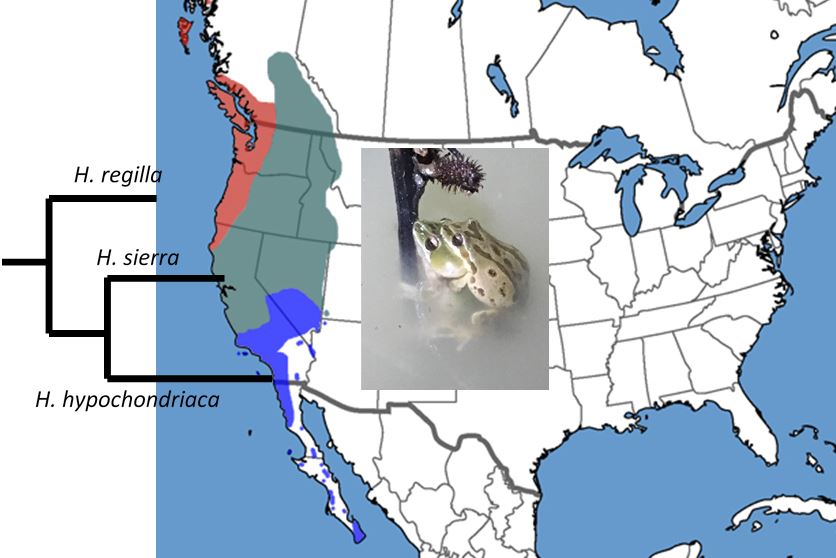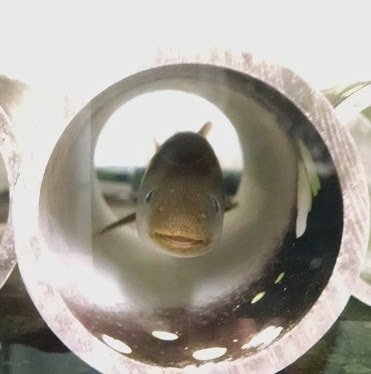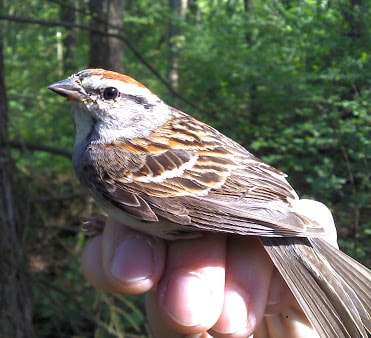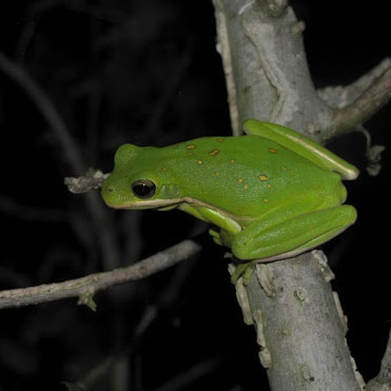We integrate ecological, behavioral, physiological, and anatomical studies, under a comparative framework, to investigate the mechanisms, function, and evolution of animal communication systems and signal-processing mechanisms.
Current ProjectsHow do sensation and perception adjust novel, human-induced environmental changes?
Noise generated by human activity has increased over the last decades, becoming one of the major forms of pollution. High levels of anthropogenic noise can have negative effects on animals, particularly those that communicate acoustically. Several studies have investigated how human-generated noise can impair the recognition of vocal communication signals. Interestingly, some studies have shown changes in signals from animals that live in cities that help them cope with the negative effects of noise. Whether and how the sense of hearing changes in response to human-generated noise is less known. Studying the iconic ‘ribbit’ of Pacific chorus frogs that live in urban and rural regions across the San Francisco Bay Area, we are exploring precisely this. We are testing the hypothesis that, among populations with different levels of natural and anthropogenic noise, the auditory system varies in ways that facilitate signal reception. We are (i) characterizing soundscapes and communication signals (Acoustics), (ii) determining how auditory processing abilities vary among soundscapes (Physiology), (iii) determining how variation in hearing relates to acoustic communication (Behavior), and (iv) determining how variation in ear morphology relates to hearing differences among soundscapes (Anatomy). This project is funded by a NSF CAREER Award |
Breeding populations (magenta) of Pacific chorus frogs around the San Francisco Bay Area are exposed to different levels of natural and anthropogenic noise. Inset: Male (top) and female Pacific chorus frogs in amplexus from the one of our study populations.
|
|
Geographic distribution and phylogenetic relationships of Pacific chorus frogs. The phylogenetic relationship between frogs of different populations along the distribution range is a matter of debate. While Barrow et al. (2014) and Banker et al. (2020) conclude there is only one species, Recuero et al. (2006), Duellman et al. (2016), and Jadin et al. (2021) divide this group into three species: Hyliola regilla (red), H. sierra (green), and H. hypochondriaca (blue). The phylogenetic relationship is redrawn from Duellman et al. (2016) and the estimated geographic distribution of each species is derived from Recuero et al. (2006) and the map from California Herps (http://www.californiaherps.com/frogs/pages/p.regilla.html).
|
Behavioral diversification and evolutionary change in auditory perception.
Animal communication signals, and signal-processing mechanisms, play a fundamental role in premating isolation. Thus, communication can maintain reproductive isolation between species and directly influence patterns of species diversification. We have learned a considerable amount about the role of the nervous system in both generating and processing communication signals. We know less about the relationship between brain evolution and the diversification of signals, perception, behavior, and species. The Pacific chorus frog species complex offers a superb opportunity to address this gap in knowledge because (i) it is unclear whether this complex is comprised of one or three species, and (ii) Pacific chorus frogs have long served as model system in studies on auditory physiology. Our preliminary results reveal strong differences between lineages of Pacific chorus frogs in call properties that are typically used in the context of species recognition. In this project, we are (i) assessing the role of natural and sexual selection on the divergence of Pacific chorus frog lineages, (ii) determining how evolutionary change in communication signals relates to variation in auditory perception and mating behavior, and (iii) characterizing neural mechanisms that underlie variation in auditory perception and mating behavior. |
|
How do pathogens affect communication systems and reproductive behavior?
Behaviors associated with reproduction, like vocal displays, territory defense, and mate selection, are energetically costly. Pathogen-induced stress may affect how much energy individuals allocate to reproduction. Chytridiomycosis, a pandemic disease caused by the chytrid fungus Batrachochytrium dendrobatidis (Bd), is a major cause of decline in amphibian biodiversity. While this disease can be lethal, some anuran species appear to be highly tolerant to chytridiomycosis. In collaboration with Dr. Vance Vredenburg, we are investigating how Bd infection affects communication and reproductive behavior in Pacific chorus frogs. |
Future Collaborations
|
How does the avian auditory system respond to increasing levels of urban noise?
Increasing levels of human-generated noise are limiting the perception of acoustic communication signals in different groups of animals, including whales, birds, amphibians, and insects. Because these signals are important for important social interactions like territory defense and mate attraction, natural selection should favor signals and receptors that maximize communication distance in a given environment. Consistent with this hypothesis, Dr. Elizabeth Derryberry has shown upward shifts in the frequency of the song of white-crowned sparrows from populations with high level of natural and anthropogenic noise in the San Francisco Bay Area. We do not know whether hearing capabilities also adjust to increasing noise levels. In collaboration with Dr. Elizabeth Derryberry, we will use white-crowned sparrows as a model system to investigate how auditory processing abilities vary across populations with different levels of natural and anthropogenic noise. |
Past ResearchWhat are the neural substrates of evolutionary change in sensory perception?
Evolutionary changes in peripheral sensory systems affect the evolution of perceptual abilities and animal communication systems, and ultimately, can lead to the formation of new species. Studies in the field of neuroecology have shown correlations between gross brain anatomy and perceptual abilities. The cellular and circuit basis for evolutionary change in sensory perception, however, remain unknown. I addressed this specific question in weakly electric fish of the family Mormyridae during my postdoctoral appointment in the lab of Dr. Bruce A. Carlson at Washington University in St. Louis. |
|
Do sensory systems match signal properties?
Communication signals are diverse and often mediate evolutionary important processes such as species recognition and mate choice. Compared to vast number of studies investigating the factors that shape communication signals and the mechanisms for signal production, we know considerably less about the factors shaping signal-processing mechanisms. As a postdoctoral research associate in the lab of Dr. Jeffrey R. Lucas at Purdue University, I used a comparative approach to investigate whether auditory processing in songbirds is phylogenetically constrained, “tuned” to species-specific properties of the vocal repertoire, or shaped to match habitat properties of sound propagation. We also investigated whether auditory processing matches seasonal changes in vocal repertoire, social behavior, and habitat structure. |
|
How do animals communicate in a noisy world?
Dense social aggregations, like human cocktail parties and frog breeding choruses, often form in the context of reproduction. The background noise generated by the mixture of signalers is a problem because it makes it hard to hear and understand individual signals. Because the ability to isolate individual signals from the background noise has important fitness consequences, we expect strong selection pressures favoring perceptual mechanisms that diminish the detrimental effects of noise. For my dissertation research, I used frogs as a model system to test the hypothesis that receivers are adapted to exploit level fluctuations typical of the natural background noise to extract information from target signals when the level of the background noise momentarily drops. In the human-hearing literature, this phenomenon is known as “dip-listening.” |






